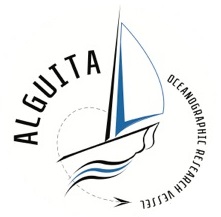THE NORTH PACIFIC 2019
On July 14, 2019 the ORV Alguita once again returned to the same area where the research began in 1999. The Alguita and I were chartered by the Korean Broadcasting System for a documentary of our research in the Eastern Garbage Patch. The goals of the voyage were; 1. Sample the center of debris accumulation based on the Hafner & Maximenko model. 2. Repeat sampling of the 11 original stations, and 3. Coordinate at-sea meeting in the accumulation zone with The Vortex Swim Group. All goals were met.
THE NORTH PACIFIC - 1999 THROUGH 2014
In 1999, I became the first to sample the surface waters of the area that has now become known as "The “Great Pacific Garbage Patch.” Algalita’s research team, under my guidance, was also the first to develop a standard methodology for sampling, and processing the samples, of ocean surface for micro-plastic debris. Since this historic voyage, Algalita has conducted many other research voyages to collect plastic pollution samples from around the world.
Research Expeditions 1999 - 2014. Our initial 1999 expedition was followed by the 2000, 2002, 2005, ** 2007, 2008 and 2009 voyages. Each successive trip indicated the ratio of plastic to plankton to be on a continual rise. ** (In 2006, I led the Greenpeace vessel, Esperanza, to what that group termed "The Trash Vortex".)
2014 North Pacific Gyre Expedition..“In August 2014, I returned with a team of scientists from six weeks at sea conducting research in the Great Pacific Garbage Patch — one of five major garbage patches drifting in the oceans north and south of the Equator at the latitude of our great terrestrial deserts. Although it was my 10th voyage to the area, I was utterly shocked to see the enormous increase in the quantity of plastic waste since my last trip in 2009. Plastics of every description---from toothbrushes to tires to unidentifiable fragments too numerous to count, floated past our marine research vessel Alguita for hundreds of miles without end. We even came upon a floating island bolstered by dozens of plastic buoys used in oyster aquaculture that had solid areas you could walk on."
In collaboration with the 5 Gyres Institute and Pangaea Explorations on board their vessel, Sea Dragon, our research continued, crossing the Trash Vortex from Oahu to Canada in 2011. Also in 2011, Tara Expeditions collected samples for Algalita during their circumnavigational expedition to Antarctica and the Southern Pacific Ocean using our protocols. With the exception of some of those collected off the Chilean Coast, plastic was found in every trawl. More samples were collected by their expedition to the North Pacific Ocean in 2012 with similar results. That summer, our joint efforts continued with 5 Gyres and Pangaea on the two-leg summer Japanese Tsunami Field Investigation with Leg 1 beginning at Majuro, Kwajelein in the South Pacific Marshall Islands to Tokyo, and Leg 2 from Tokyo to Oahu.
A 15-year retrospective study of our work in the North Pacific Subtropical Gyre covering the 1999, 2008, 2009 and 2014 voyages is currently in preparation and will be published soon. By combining information collected during these expeditions, our researchers are working to evaluate the long term trends, changes, and environmental impacts of plastic pollution we’ve observed over the past 15 years. This project will yield valuable information enabling the scientific community to assess prevention efforts related to ocean plastic pollution. In addition, results from this study will be used to develop critical updates to educational curriculum. It will also serve as the basis to create a series of interactive infographics for public use through Algalita’s Plastic Ocean Index, which contains data from all Algalita research, as well as data from other researchers and citizen scientists.
All expeditions have resulted in an extensive body of scientific data, peer-reviewed publications, articles and educational programs, all available through Algalita Marine Research and Education. On all four voyages, we monitored the same eleven stations of our original 1999 sample design. No one else has done this type of monitoring. Our work in the North Pacific Gyre is far from complete and Algalita is committed to continue monitoring the impact of plastic pollution on this dynamic ecosystem for years to come.


